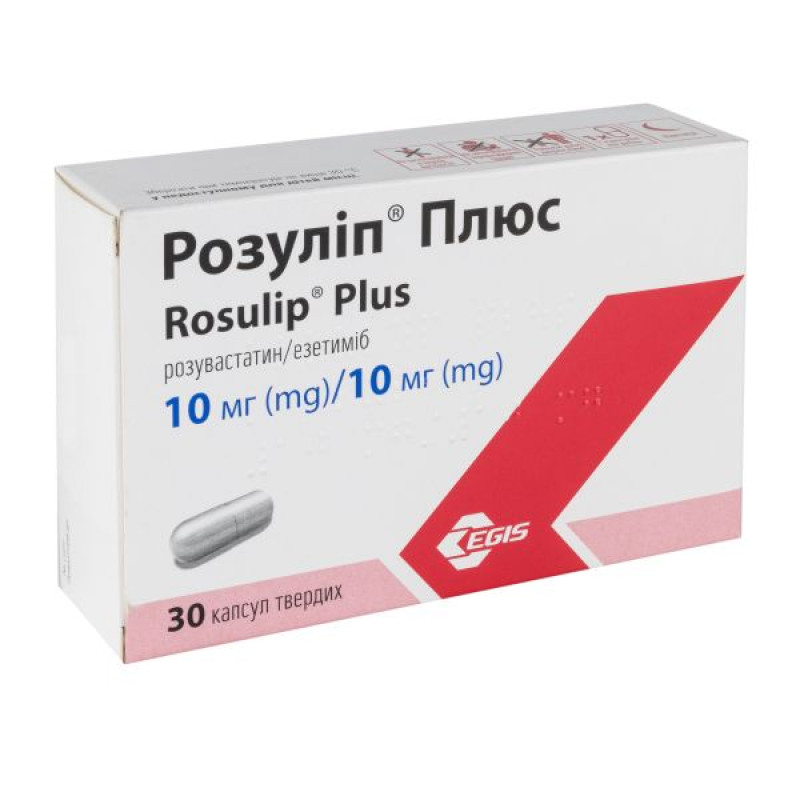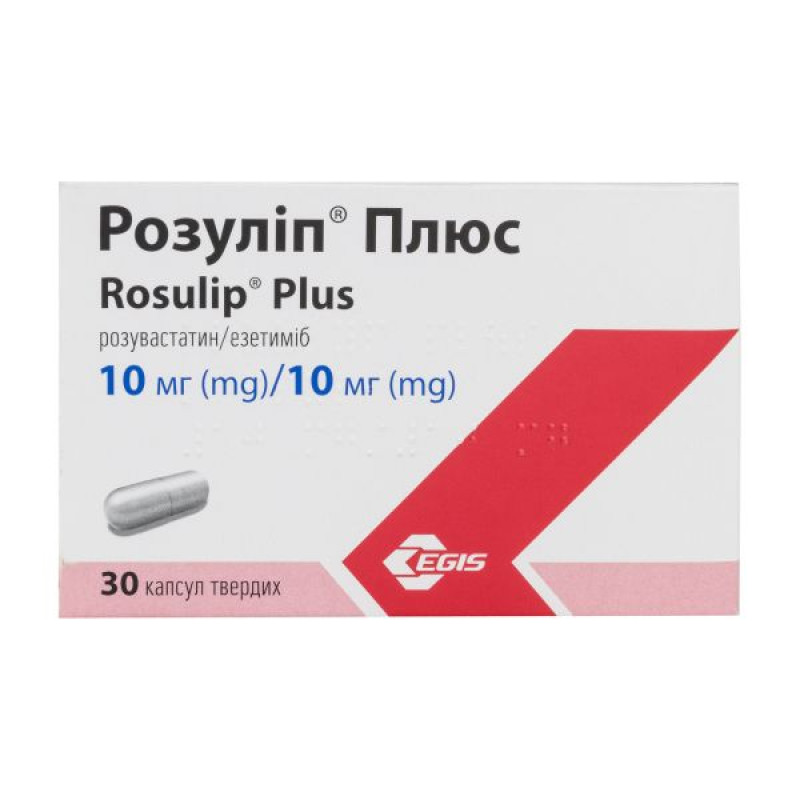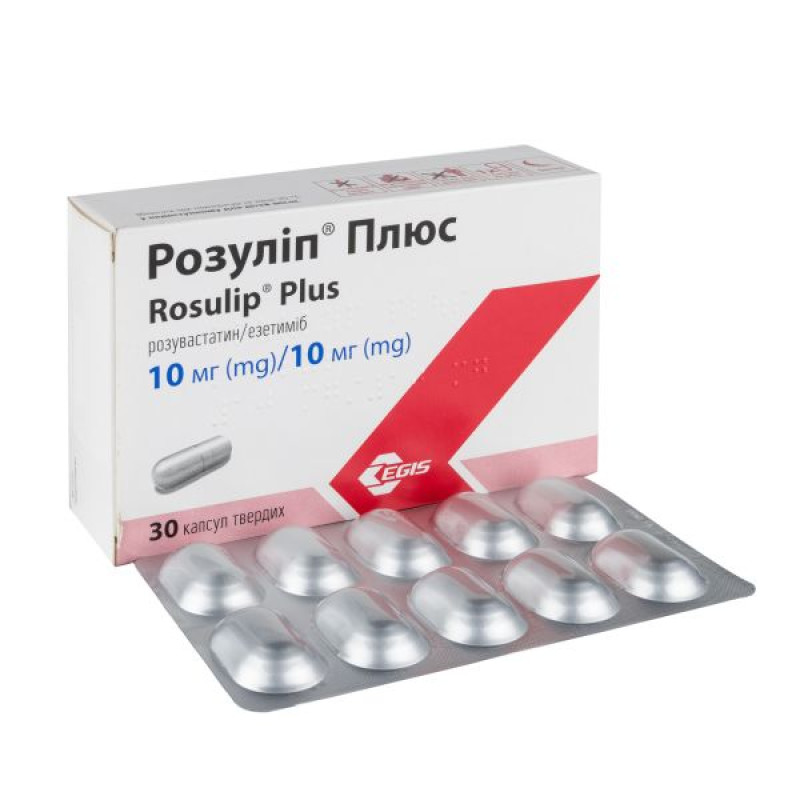Rozulip Plus tablets 10 mg + 10 mg blister No. 30

Instructions for use Rozulip Plus tablets 10 mg + 10 mg blister No. 30
Composition
active ingredients: rosuvastatin, ezetimibe;
1 capsule contains two tablets:
1 tablet of rosuvastatin 10 mg (as rosuvastatin zinc) and 1 tablet of ezetimibe 10 mg;
excipients:
for rosuvastatin tablets:
microcrystalline silicon cellulose, colloidal anhydrous silicon dioxide, magnesium stearate;
for ezetimibe tablets:
povidone, croscarmellose sodium, microcrystalline cellulose, mannitol, sodium lauryl sulfate, low-substituted hydroxypropylcellulose, magnesium stearate;
composition of the 10 mg/10 mg capsule: iron oxide yellow (E172), titanium dioxide (E171), gelatin.
Dosage form
The capsules are hard.
Main physicochemical properties:
capsules of 10 mg/ 10 mg:
Hard gelatin capsules, unmarked, self-closing, with a yellow body and a yellow cap. Each capsule contains two tablets.
Rosuvastatin 10 mg tablet: white or almost white oblong tablets with a bevel, engraved with a stylized letter E and the number 596 on one side of the tablet, odorless or almost odorless;
Ezetimibe 10 mg tablet: white or almost white, round, flat, beveled tablets, engraved with a stylized letter E on one side of the tablet and the number 612 on the other side of the tablet, odorless or almost odorless.
Pharmacotherapeutic group
HMG-CoA reductase inhibitors in combination with other hypolipidemic agents.
ATX code C10B A06.
Pharmacological properties
Pharmacodynamics
Rosuvastatin
Rosuvastatin is a selective competitive inhibitor of HMG-CoA reductase, an enzyme that regulates the rate of conversion of 3-hydroxy-3-methyl-glutaryl-coenzyme A to mevalonate, a precursor of cholesterol.
The main target of rosuvastatin is the liver, where cholesterol synthesis occurs.
Rosuvastatin increases the number of hepatic low-density lipoprotein (LDL) receptors on the cell surface, increasing the uptake and catabolism of LDL, which enhances the uptake and catabolism of LDL and, in turn, leads to inhibition of the synthesis of very low-density lipoprotein (VLDL), thereby reducing the total amount of LDL and VLDL.
Rosuvastatin reduces elevated LDL cholesterol, total cholesterol, and triglycerides, and slightly increases high-density lipoprotein (HDL) cholesterol.
It also reduces apolipoprotein B, non-HDL cholesterol, VLDL cholesterol, VLDL triglycerides and slightly increases apolipoprotein A-I. Rosuvastatin also reduces the LDL-cholesterol/HDL-cholesterol ratio, total cholesterol/HDL-cholesterol, non-LDL-cholesterol/HDL-cholesterol ratio and the apolipoprotein B/apolipoprotein A-I ratio.
The therapeutic effect is manifested within 1 week after the start of rosuvastatin therapy, after 2 weeks of treatment the effect reaches 90% of the maximum possible. The maximum effect is usually achieved 4 weeks after the start of treatment.
Ezetimibe
Ezetimibe is a member of a new class of lipid-lowering agents that selectively inhibit the intestinal absorption of cholesterol and related plant sterols. Ezetimibe is orally active and has a mechanism of action that is distinct from other classes of cholesterol-lowering drugs (e.g., statins, bile acid sequestrants (resins), acid-derived fibrates, and plant stanols). The molecular target of ezetimibe is the sterol transporter Niemann-Pick Cl-Like 1 (NPC1L1), which is responsible for the absorption of cholesterol and phytosterols in the intestine.
Ezetimibe localizes to the brush border of the small intestine and inhibits cholesterol absorption by reducing the delivery of intestinal cholesterol to the liver; statins reduce cholesterol synthesis in the liver, and together these mechanisms provide additional cholesterol reduction. After 2 weeks of clinical use in 18 patients with hypercholesterolemia, ezetimibe reduced cholesterol absorption by 54% compared with placebo.
A series of preclinical studies were conducted to determine the selectivity of ezetimibe for inhibiting cholesterol absorption. Ezetimibe inhibited the absorption of [14C]-cholesterol without affecting the absorption of triglycerides, fatty acids, bile acids, progesterone, ethinyl estradiol, or the fat-soluble vitamins A and D.
Epidemiological studies have established that cardiovascular morbidity and mortality vary directly proportionally to the level of total cholesterol and LDL-C and inversely proportionally to the level of HDL-C.
The effect of ezetimibe on cardiovascular morbidity and mortality has not yet been demonstrated.
Pharmacokinetics
Ezetimibe
Absorption. After oral administration, ezetimibe is rapidly absorbed and extensively conjugated to form a pharmacologically active phenolic glucuronide (ezetimibe-glucuronide). The mean maximum plasma concentration (Cmax) of ezetimibe-glucuronide is reached after 1–2 hours, and of ezetimibe after 4–12 hours. The absolute bioavailability of ezetimibe cannot be determined because this compound is insoluble in water.
Concomitant food intake (low or high fat) does not affect the oral bioavailability of ezetimibe, particularly ezetimibe 10 mg. Ezetimibe can be taken without regard to meals.
Metabolism. Ezetimibe is metabolized in the small intestine and liver by conjugation with glucuronide (phase II reaction) followed by biliary excretion. Minimal oxidative metabolism (phase I reaction) was observed at all stages of transformation. Ezetimibe and ezetimibe-glucuronide are the major substances detected in plasma, accounting for approximately 10–20% and 80–90% of the total plasma drug content, respectively. Ezetimibe and ezetimibe-glucuronide are slowly eliminated from plasma by enterohepatic recirculation. The elimination half-life of ezetimibe and ezetimibe-glucuronide is approximately 22 hours.
Elimination: Following oral administration of 20 mg of 14C-ezetimibe to volunteers, approximately 93% of the total ezetimibe recovered in plasma was derived from the total plasma radioactivity. Approximately 78% and 11% of the administered radioactive dose were excreted in the feces and urine, respectively, within 10 days. No detectable levels of radioactivity were observed in plasma after 48 hours.
Special populations
Elderly patients
In elderly patients (over 65 years of age), plasma concentrations of total ezetimibe are approximately twice as high as in younger patients (18–45 years of age). The LDL-C reduction and safety profile are approximately the same in elderly and younger patients taking ezetimibe. Therefore, no dose adjustment is necessary for elderly patients.
Patients with hepatic insufficiency
After a single dose of 10 mg ezetimibe, the mean area under the plasma concentration-time curve (AUC) of total ezetimibe was 1.7-fold higher in patients with mild hepatic impairment (Child-Pugh score 5-6) than in healthy volunteers. In a 14-day study of ezetimibe (10 mg daily) in patients with moderate hepatic impairment (Child-Pugh score 7-9), the AUC of total ezetimibe increased approximately 4-fold on days 1 and 14 compared with healthy volunteers. No dose adjustment is necessary for patients with mild hepatic impairment. Since the effects of increased ezetimibe levels in patients with moderate or severe hepatic impairment (Child-Pugh score greater than 9) are unknown, Rosuvastatin is not recommended for use in this patient population (see Precautions).
Patients with renal insufficiency
Following a single dose of 10 mg ezetimibe in patients with severe renal impairment (n = 8; creatinine clearance ≤ 30 mL/min/1.73 m2), the mean AUC of total ezetimibe increased approximately 1.5-fold compared to healthy volunteers (n = 9). This finding is not considered clinically significant. No dose adjustment is necessary for patients with renal impairment.
In this study, one patient (who had a kidney transplant and was receiving multitherapy, including cyclosporine) had a 12-fold higher total ezetimibe level.
Sex
Plasma concentrations of total ezetimibe are slightly higher (approximately 20%) in women than in men. The LDL-C reduction and safety profile are approximately the same in men and women taking Rosulip® Plus. Therefore, no dose adjustment is necessary based on gender.
Rosuvastatin
Absorption
Cmax of rosuvastatin in blood plasma is reached approximately 5 hours after oral administration. Bioavailability is approximately 20%.
Distribution
The volume of distribution of rosuvastatin is approximately 134 L. Almost 90% of rosuvastatin binds to plasma proteins, mainly albumin.
Metabolism
Rosuvastatin undergoes limited metabolism (approximately 10%). Rosuvastatin is a weak substrate for metabolism by cytochrome P450 enzymes.
The main isoenzyme involved in the metabolism of rosuvastatin is CYP2C9.
CYP2C19, CYP3A4 and CYP2D6 enzymes are less active. The main metabolites of rosuvastatin identified are N-desmethyl and lactone metabolites. N-desmethyl is approximately 50% less active than rosuvastatin, lactone metabolites are pharmacologically inactive. More than 90% of the pharmacological activity directed at inhibiting circulating HMG-CoA reductase is provided by rosuvastatin.
Breeding
Approximately 90% of the rosuvastatin dose is excreted unchanged in the feces (including absorbed and unabsorbed rosuvastatin). The remainder of the active substance is excreted in the urine. Almost 5% is found in the urine unchanged. The half-life is approximately 9 hours. The half-life does not change with increasing dose. The geometric mean clearance is approximately 50 l/h (coefficient of variation 21.7%).
As with other HMG-CoA reductase inhibitors, the membrane cholesterol transporter OATP-C is involved in the hepatic uptake of rosuvastatin. The transporter plays an important role in the hepatic elimination of rosuvastatin.
Linearity. Systemic exposure to rosuvastatin increases in proportion to the dose. Pharmacokinetic parameters do not change after multiple daily doses.
Special patient groups
Age and gender have no clinically significant effect on the pharmacokinetics of rosuvastatin.
No genetic or environmental factors were found to influence the differences in pharmacokinetic parameters. Pharmacokinetic analysis of different ethnic groups did not reveal clinically significant differences in the pharmacokinetics of patients of Caucasian and Mongoloid races.
Patients with renal insufficiency. In patients with mild or moderate renal impairment, the plasma concentrations of rosuvastatin and N-desmethyl do not change significantly. In patients with severe renal insufficiency (creatinine clearance < 30 ml/min), the plasma concentration of rosuvastatin is 3 times higher, and the concentration of N-desmethyl is 9 times higher, than in healthy volunteers. The equilibrium plasma concentration of rosuvastatin in patients on hemodialysis was approximately 50% higher than in healthy volunteers.
Patients with hepatic impairment. Among patients with varying degrees of hepatic impairment, no increase in the half-life of rosuvastatin was observed if the Child-Pugh score did not exceed 7. However, two patients with Child-Pugh scores of 8 and 9 had at least a twofold increase in the half-life.
There is no experience with the use of rosuvastatin in patients with a score above 9 on the Child-Pugh scale.
Indication
As an adjunct to diet for patients with primary hypercholesterolemia when a combination drug is appropriate:
for patients who have not achieved an adequate result when treated with a statin alone; replacement therapy for patients with sufficient disease control with the combined use of rosuvastatin and ezetimibe in the same doses as the fixed combination Rozulip® Plus.
Contraindication
Hypersensitivity to the active substances or to any of the excipients of the drug; active liver disease, including persistent elevation of serum transaminases of unknown etiology and any elevation of serum transaminase levels three times or more of the upper limit of normal (ULN); severe renal impairment (creatinine clearance < 30 ml/min); myopathy; concomitant use of cyclosporine; children; pregnancy, breastfeeding; contraindicated in women of reproductive age not using effective contraception.
Interaction with other medicinal products and other types of interactions
Transport protein inhibitors
Rosuvastatin is a substrate for several transport proteins, including the hepatic uptake transporter OATP1B1 and the efflux transporter BCRP. Concomitant use of rosuvastatin with medicinal products that inhibit these transport proteins may lead to increased plasma concentrations of rosuvastatin and an increased risk of myopathy (see sections 4.2, 4.4, and 4.5).
Cyclosporine
During concomitant use of rosuvastatin and ciclosporin, rosuvastatin AUC values were on average approximately 7 times higher than those observed in healthy volunteers (see Table 1). Rosuvastatin is contraindicated in patients receiving concomitant ciclosporin (see section "Contraindications").
Protease inhibitors
Although the exact mechanism of interaction is unknown, concomitant use of protease inhibitors may significantly increase rosuvastatin exposure (see Table 1). For example, in a pharmacokinetic study, co-administration of 10 mg of rosuvastatin and a combination product containing two protease inhibitors (300 mg atazanavir/100 mg ritonavir) in healthy volunteers was accompanied by an increase in rosuvastatin AUC and Cmax by approximately 3 and 7 times, respectively. Co-administration of Rosuvastatin and some combinations of protease inhibitors may be possible after dose adjustment of Rosuvastatin based on the expected increase in rosuvastatin exposure (see sections 4.2, 4.4, and 4.5, Table 1).
Gemfibrozil and other lipid-lowering agents
Simultaneous use of Rozulip® Plus and gemfibrozil led to a 2-fold increase in rosuvastatin AUC and Cmax (see section "Special instructions").
Based on specific studies, no pharmacokinetically significant interaction with fenofibrate is expected, but a pharmacodynamic interaction is possible. Gemfibrozil, fenofibrate, other fibrates, and lipid-lowering doses of niacin (nicotinic acid) (1 g/day or more) increase the risk of myopathy when used concomitantly with HMG-CoA inhibitors, presumably because they can cause myopathy when used alone. The 40 mg dose is contraindicated with concomitant use of fibrates (see sections 4.3 and 4.4). Concomitant administration of fenofibrate or gemfibrozil increases total ezetimibe concentrations by approximately 1.5-1.7 times, respectively. Although this increase is not considered clinically significant, concomitant administration of Rosuvastatin with gemfibrozil is contraindicated and not recommended with other fibrates.
If cholelithiasis is suspected in a patient taking ezetimibe and fenofibrate, gallbladder examination is indicated, and such therapy should be discontinued.
Concomitant administration of fenofibrate or gemfibrozil moderately increases total ezetimibe concentrations (approximately 1.5-1.7-fold, respectively).
Combination therapy with ezetimibe and other fibrates has not been studied.
Fibrates may increase cholesterol excretion into the bile, leading to gallstone disease. In animal studies, ezetimibe has occasionally increased cholesterol levels in gallbladder bile, but not in all species. There is no evidence of a risk of gallstone formation associated with the therapeutic use of ezetimibe.
Antacids
Simultaneous use of Rozulip® Plus with antacid suspensions containing aluminum or magnesium hydroxide reduced the concentration of rosuvastatin in the blood plasma by approximately 50%. This effect was less pronounced when antacids were used 2 hours after taking Rozulip® Plus. The clinical significance of this interaction has not been studied.
Concomitant administration of antacids reduces the extent of absorption of ezetimibe, but does not affect its bioavailability. This decrease in the extent of absorption is not considered clinically significant.
Erythromycin
Concomitant use of rosuvastatin and erythromycin decreased rosuvastatin AUC by 20% and Cmax by 30%. This interaction may be due to increased intestinal motility due to erythromycin.
Cytochrome P450 enzymes
In vitro and in vivo studies have shown that rosuvastatin does not inhibit or induce cytochrome P450 isoenzymes. In addition, rosuvastatin is a weak substrate for these isoenzymes. Therefore, drug interactions resulting from P450-mediated metabolism are not expected. No clinically significant interactions were observed between rosuvastatin and fluconazole (an inhibitor of CYP2C9 and CYP3A4) or ketoconazole (an inhibitor of CYP2A6 and CYP3A4).
In nonclinical studies, ezetimibe did not induce cytochrome P450 drug-metabolizing enzymes. No clinically significant pharmacokinetic interactions were observed between ezetimibe and drugs metabolized by cytochrome P450: 1A2, 2D6, 2C8, 2C9, 3A4, or N-acetyltransferase.
Interactions requiring dose adjustment of rosuvastatin
If it is necessary to use rosuvastatin with other drugs that can increase the exposure of rosuvastatin, the dose of the drug should be adjusted. If the exposure of the drug (AUC) is expected to increase by approximately 2 or more times, the use of Rosulip® Plus should be started at a dose of 5 mg once a day. The maximum daily dose of Rosulip® Plus should be adjusted so that the expected exposure of rosuvastatin does not exceed the exposure observed when taking a dose of 40 mg/day without the use of drugs that interact with the drug; for example, when used with gemfibrozil, the dose of Rosulip® Plus will be 20 mg (an increase in exposure of 1.9 times), when used with a combination of ritonavir/atazanavir - 10 mg (an increase of 3.1 times), when used simultaneously with cyclosporine - 5 mg (an increase of 7.1 times).
Table 1
Effect of concomitant medications on rosuvastatin exposure (AUC; in descending order of magnitude) based on published clinical trial data
| Dosing regimen of the interacting drug | Rosuvastatin dosage regimen | Changes in rosuvastatin AUC* |
| Cyclosporine 75 mg twice daily to 200 mg twice daily, 6 months | 10 mg once daily, 10 days | ↑ 7.1 times |
| Atazanavir 300 mg/ritonavir 100 mg once daily, 8 days | 10 mg, single dose | ↑ 3.1 times |
| Simeprivir 150 mg once daily, 7 days | 10 mg, single dose | ↑ 2.8 times |
| Lopinavir 400 mg/ritonavir 100 mg twice daily, 17 days | 20 mg once daily, 7 days | ↑ 2.1 times |
| Gemfibrozil 600 mg twice daily, 7 days | 80 mg, single dose | ↑ 1.9 times |
| Eltrombopac 75 mg once daily, 5 days | 10 mg, single dose | ↑ 1.6 times |
| Darunavir 600 mg/ritonavir 100 mg twice daily, 7 days | 10 mg once daily, 7 days | ↑ 1.5 times |
| Tipranavir 500 mg/ritonavir 200 mg twice daily, 11 days | 10 mg, single dose | ↑ 1.4 times |
| Dronedarone 400 mg twice daily | Unknown | ↑ 1.4 times |
| Itraconazole 200 mg once daily, 5 days | 10 mg, single dose | ↑ 1.4 times ** |
| Ezetimibe 10 mg once daily, 14 days | 10 mg once daily, 14 days | ↑ 1.2 times ** |
| Fosamprenavir 700 mg/ritonavir 100 mg twice daily, 8 days | 10 mg, single dose | ↔ |
| Aleglitazar 0.3 mg, 7 days | 40 mg, 7 days | ↔ |
| Silymarin 140 mg three times a day, 5 days | 10 mg, single dose | ↔ |
| Fenofibrate 67 mg three times a day, 7 days | 10 mg, 7 days | ↔ |
| Rifampin 450 mg once daily, 7 days | 20 mg, single dose | ↔ |
| Ketoconazole 200 mg twice daily, 7 days | 80 mg, single dose | ↔ |
| Fluconazole 200 mg once daily, 11 days | 80 mg, single dose | ↔ |
| Erythromycin 500 mg four times a day, 7 days | 80 mg, single dose | ↓ 20% |
| Baicalin 50 mg three times a day, 14 days | 20 mg, single dose | ↓ 47% |









